

 |
|
 | |
 The dark Marilyn she has been called. Not a particularly profound observation - who could be darker than Marilyn? And, if we stick to the superficial - who could be more cheerful, not to say innocent, in her mischief than Bettie - whether it be swim-suit poses on a public beach or private photo sessions with leather and ropes?
The dark Marilyn she has been called. Not a particularly profound observation - who could be darker than Marilyn? And, if we stick to the superficial - who could be more cheerful, not to say innocent, in her mischief than Bettie - whether it be swim-suit poses on a public beach or private photo sessions with leather and ropes?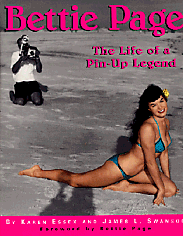 |
Bettie Page - The Life of a Pin-up Legend, by Karen Essex and James L. Swanson (General Publishing, Santa Monica 1996, 288 p, ISBN: 1-881649-62-8). |
 Bettie Page is a woman of integrity, she does not reveal much about what was going on under the surface in this new coffee table book about her life and career, although she has submitted a short preface of her own hand. This is truly a 90's product, an artifact from this present day, when the paraphernalia of assorted partial sexual drives have become household knowledge. At the same time the book emits the alleged naive charm of easily listenable music and cocktail parties of the 50's - when cigarettes still were good for you and chronic fatigue syndrome was unheard of - not to mention women's lib ...
Bettie Page is a woman of integrity, she does not reveal much about what was going on under the surface in this new coffee table book about her life and career, although she has submitted a short preface of her own hand. This is truly a 90's product, an artifact from this present day, when the paraphernalia of assorted partial sexual drives have become household knowledge. At the same time the book emits the alleged naive charm of easily listenable music and cocktail parties of the 50's - when cigarettes still were good for you and chronic fatigue syndrome was unheard of - not to mention women's lib ... A powerful Bettie Page revival is going on right now, that is quite unmistakable. While working on this article, I had only to watch TV for a couple of days to see Bettie's image flicker by three times: in the George Michael video Fast Love from this year, in the Swedish movie The Summer ("Sommaren", from 1995), directed by Kristian Petri, and in the John Waters movie Serial Mom from 1994.
A powerful Bettie Page revival is going on right now, that is quite unmistakable. While working on this article, I had only to watch TV for a couple of days to see Bettie's image flicker by three times: in the George Michael video Fast Love from this year, in the Swedish movie The Summer ("Sommaren", from 1995), directed by Kristian Petri, and in the John Waters movie Serial Mom from 1994. Bettie Page never really fit into the stereotype of an American pin-up girl. Her measurements were hardly those of a Jane Mansfield, her lips were to thin, and if you look closely, you may see that she has a slow right eye. There were also something homespun about her bikinis. And they actually were, she designed and sew them herself.
Bettie Page never really fit into the stereotype of an American pin-up girl. Her measurements were hardly those of a Jane Mansfield, her lips were to thin, and if you look closely, you may see that she has a slow right eye. There were also something homespun about her bikinis. And they actually were, she designed and sew them herself. Models came and went in rapid succession at this time. Few of them lasted for more than two or three years. Apart from Bettie, perhaps Diane Webber did. And very few of them appeared in both worlds - over and under the counter.
Models came and went in rapid succession at this time. Few of them lasted for more than two or three years. Apart from Bettie, perhaps Diane Webber did. And very few of them appeared in both worlds - over and under the counter. | There were lots and lots of magazines like this one, but if you were even more broadminded, you had to look under the counter. | 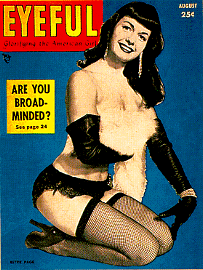 |
 No matter how it is written, a book like this with more than 500 pictures on 388 pages must be remarkable. The text, however, is adequate, written in a rather neutral, still sympathetic, reporting tone.
No matter how it is written, a book like this with more than 500 pictures on 388 pages must be remarkable. The text, however, is adequate, written in a rather neutral, still sympathetic, reporting tone. It is also remarkable how the book came to be. The attorney James Swanson was hired to protect Bettie's rights and integrity when the revival really started around 1991-92. At this time she was still living anonymously, but several people were trying to trace her down and write her story. Writer and journalist Karen Essex had written an article about Bettie Page for L.A Weekly. Swanson sent Bettie the article, and she liked it. So, if anyone was going to write the true story about this pin-up legend, it was Essex & Swanson.
It is also remarkable how the book came to be. The attorney James Swanson was hired to protect Bettie's rights and integrity when the revival really started around 1991-92. At this time she was still living anonymously, but several people were trying to trace her down and write her story. Writer and journalist Karen Essex had written an article about Bettie Page for L.A Weekly. Swanson sent Bettie the article, and she liked it. So, if anyone was going to write the true story about this pin-up legend, it was Essex & Swanson. Some of her fans today could be her grandchildren, as she herself remarks in a specially written preface to the book. "If I am remembered today, it is because you, the reader, see something in me that I never saw in myself," Bettie writes in her foreword. Does she mean exactly that, or does she mean "something in me that I never saw myself"? Did we, her audience, discover something or did we invent something?
Some of her fans today could be her grandchildren, as she herself remarks in a specially written preface to the book. "If I am remembered today, it is because you, the reader, see something in me that I never saw in myself," Bettie writes in her foreword. Does she mean exactly that, or does she mean "something in me that I never saw myself"? Did we, her audience, discover something or did we invent something? Bettie Mae Page is a Southern girl. She was born in Jackson, Tennessee, in 1923, on April 22 at 3 a.m., which makes her a Taurus with Pisces rising. If you know anything about the amphibious signs of the zodiac, it is not so surprising to read her biography, a story of sensuality and kindness, combined with a spiritual urge, and a capacity to calmly grab what the moment has to offer.
Bettie Mae Page is a Southern girl. She was born in Jackson, Tennessee, in 1923, on April 22 at 3 a.m., which makes her a Taurus with Pisces rising. If you know anything about the amphibious signs of the zodiac, it is not so surprising to read her biography, a story of sensuality and kindness, combined with a spiritual urge, and a capacity to calmly grab what the moment has to offer.  Bettie was the second of Roy and Edna Page's six children. Roy was an auto mechanic, and "a womanizer", somewhat cruel and sex crazy it seems. Edna divorced Roy after he had made a 17-year old girl pregnant. As if they hadn't been poor enough before, the rest of the family was now without any support from Roy Page. This was in 1933, and Bettie was ten years old.
Bettie was the second of Roy and Edna Page's six children. Roy was an auto mechanic, and "a womanizer", somewhat cruel and sex crazy it seems. Edna divorced Roy after he had made a 17-year old girl pregnant. As if they hadn't been poor enough before, the rest of the family was now without any support from Roy Page. This was in 1933, and Bettie was ten years old.  Edna put Bettie and two of her sisters into an orphanage for a year:
Edna put Bettie and two of her sisters into an orphanage for a year: "In the orphanage my sisters and I would play a game we called 'program.' We would get movie star pictures from the magazines, and there was a color section in the newspaper on Sunday of movie star pictures, and we would mimic the movie star poses. I guess that's where I started learning how to pose, because I never took any courses or anything. I just always knew what to do with my body," Bettie says in an online interview in March 1996 at Starwave's Celebrity Lounge.
"In the orphanage my sisters and I would play a game we called 'program.' We would get movie star pictures from the magazines, and there was a color section in the newspaper on Sunday of movie star pictures, and we would mimic the movie star poses. I guess that's where I started learning how to pose, because I never took any courses or anything. I just always knew what to do with my body," Bettie says in an online interview in March 1996 at Starwave's Celebrity Lounge. Later Edna offered Roy to rent a room in their house, to somewhat lighten their economic burden. This was indeed a mistake. Roy Page began to abuse his daughter sexually. He payed for her silence with movie tickets. This was a silence that lasted 59 years. In the book Bettie says that she didn't understand until later what had happened to her. She was very innocent and unknowing at the time. When she had her first menstruation she believed she was dying.
Later Edna offered Roy to rent a room in their house, to somewhat lighten their economic burden. This was indeed a mistake. Roy Page began to abuse his daughter sexually. He payed for her silence with movie tickets. This was a silence that lasted 59 years. In the book Bettie says that she didn't understand until later what had happened to her. She was very innocent and unknowing at the time. When she had her first menstruation she believed she was dying.  To speculate about this experience of abuse and what it meant for Bettie's later inclination, would of course be easy but a little beyond the scope of this article. And Essex & Swanson don't dwell on it either. We do, however, get to know that Bettie, during her teens, concentrated on her studies, she did not go out with boys, and the possibilities of marrying rich was never an option for her. She wanted a career of her own. At the Hume-Fogg High School, she indulged in extracurricular activities such as the Dramatics Club. She worked very hard, without any encouragement from her parents, to get a scholarship to Vanderbilt University. She failed, but instead she got a scholarship to a teacher's college. This was in 1940, and Bettie was 17 years old.
To speculate about this experience of abuse and what it meant for Bettie's later inclination, would of course be easy but a little beyond the scope of this article. And Essex & Swanson don't dwell on it either. We do, however, get to know that Bettie, during her teens, concentrated on her studies, she did not go out with boys, and the possibilities of marrying rich was never an option for her. She wanted a career of her own. At the Hume-Fogg High School, she indulged in extracurricular activities such as the Dramatics Club. She worked very hard, without any encouragement from her parents, to get a scholarship to Vanderbilt University. She failed, but instead she got a scholarship to a teacher's college. This was in 1940, and Bettie was 17 years old. In college she continued to play theater, and she dated a boy named Billy Neal, whom she even married, mostly to be kind to him, since he got drafted after Pearl Harbor. Husband Billy didn't care much either for her college studies, he thought she acted "high and mighty", while she only wished she could discuss literature with him.
In college she continued to play theater, and she dated a boy named Billy Neal, whom she even married, mostly to be kind to him, since he got drafted after Pearl Harbor. Husband Billy didn't care much either for her college studies, he thought she acted "high and mighty", while she only wished she could discuss literature with him.  After graduating in 1944 she moved to San Francisco (where Billy was stationed), and worked as a secretary. She was photographed by some sort of Hollywood agent, the pictures were sent to L.A. and she was tested for the screen. This didn't work out, though, the movie people tried to de-southernize her and de-naturalize her into something like Joan Crawford. Back in San Francisco she took a modeling course, and her first job in this new profession was showing fur coats for the company where she worked as secretary, Geary Furriers.
After graduating in 1944 she moved to San Francisco (where Billy was stationed), and worked as a secretary. She was photographed by some sort of Hollywood agent, the pictures were sent to L.A. and she was tested for the screen. This didn't work out, though, the movie people tried to de-southernize her and de-naturalize her into something like Joan Crawford. Back in San Francisco she took a modeling course, and her first job in this new profession was showing fur coats for the company where she worked as secretary, Geary Furriers.  | ||
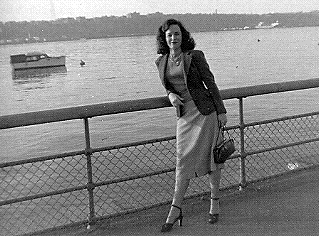 | Bettie in New York in 1949, then 26 years old and working as a secretary. | |
 | ||
 After the war Bettie moved to Nashville, she divorced Billy, and in 1947 she moved to New York - after a short adventure as a secretary for a furniture firm in Haiti. In New York she hoped to carry out her acting plans (she did study with Herbert Berghof later on, in '53, and appeared in a couple of off-Broadway shows in '56). While working in an office at Rockefeller Plaza, she fell in love with a handsome Peruvian from Lima, Carlos Garcia Arrese. They were passionately in love, and Bettie was very happy - until she found out that the man was married. If I ever was in love with a man, it was with Carlos, Bettie says in Essex & Swanson's book.
After the war Bettie moved to Nashville, she divorced Billy, and in 1947 she moved to New York - after a short adventure as a secretary for a furniture firm in Haiti. In New York she hoped to carry out her acting plans (she did study with Herbert Berghof later on, in '53, and appeared in a couple of off-Broadway shows in '56). While working in an office at Rockefeller Plaza, she fell in love with a handsome Peruvian from Lima, Carlos Garcia Arrese. They were passionately in love, and Bettie was very happy - until she found out that the man was married. If I ever was in love with a man, it was with Carlos, Bettie says in Essex & Swanson's book.  And then: one day in 1950, while walking on a deserted beach at Coney Island, she was approached by a policeman - Jerry Tibbs. Tibbs had a hobby - photography. Had she ever done any photographic modeling? He helped her with a portfolio and her first cover was that of a Harlem newsprint magazine. She was introduced to the camera clubs, where she did private photo sessions for a whole group of photographers. Soon she was the most popular model at the clubs:
And then: one day in 1950, while walking on a deserted beach at Coney Island, she was approached by a policeman - Jerry Tibbs. Tibbs had a hobby - photography. Had she ever done any photographic modeling? He helped her with a portfolio and her first cover was that of a Harlem newsprint magazine. She was introduced to the camera clubs, where she did private photo sessions for a whole group of photographers. Soon she was the most popular model at the clubs: "I enjoyed my modeling years because I would pose for two hours and make more than working all week as a secretary," Bettie said in the online chat at Celebrity Lounge. "I had plenty of free time to redecorate my apartment. I had a nice little apartment with a small bedroom and living room, a small kitchenette, downtown on 46th Street, right close to Broadway, and all I paid was $46.29 a month."
"I enjoyed my modeling years because I would pose for two hours and make more than working all week as a secretary," Bettie said in the online chat at Celebrity Lounge. "I had plenty of free time to redecorate my apartment. I had a nice little apartment with a small bedroom and living room, a small kitchenette, downtown on 46th Street, right close to Broadway, and all I paid was $46.29 a month." Since the club photographs were not supposed to be published, they were more daring. So, here Bettie posed nude. She wasn't embarrassed even the first time, she says. It just never occurred to her to be shy in front of the camera.
Since the club photographs were not supposed to be published, they were more daring. So, here Bettie posed nude. She wasn't embarrassed even the first time, she says. It just never occurred to her to be shy in front of the camera.  It was Tibbs who suggested to Bettie that she should wear those famous bangs - to hide her somewhat protruding forehead.
It was Tibbs who suggested to Bettie that she should wear those famous bangs - to hide her somewhat protruding forehead. Not only was the nudity controversial. At the Concorde Camera Club, there were many black photographers, and Bettie often posed for them - definitely a no-no at the time, for a Southern girl of course, but actually for any white girl.
Not only was the nudity controversial. At the Concorde Camera Club, there were many black photographers, and Bettie often posed for them - definitely a no-no at the time, for a Southern girl of course, but actually for any white girl.  In 1951 her image migrated from the camera clubs to the covers of men's magazines like Wink, Titter, Dare, Bold, Male Life, Black Nylons, Slick, Breezy, Jest, Joker, He, Gaze, She, Stare, Tab, Beauty Parade, or Eyeful - and of course, Sunbathing for Health Magazine. Bettie always liked best to pose outdoors. And, as a matter of fact, she always looked extremely healthy. As Essex & Swanson point out, at this time Bettie clowns and goofs and teases for the camera, but the confident seductress had not yet emerged. True. There are smiles, and there are smiles.
In 1951 her image migrated from the camera clubs to the covers of men's magazines like Wink, Titter, Dare, Bold, Male Life, Black Nylons, Slick, Breezy, Jest, Joker, He, Gaze, She, Stare, Tab, Beauty Parade, or Eyeful - and of course, Sunbathing for Health Magazine. Bettie always liked best to pose outdoors. And, as a matter of fact, she always looked extremely healthy. As Essex & Swanson point out, at this time Bettie clowns and goofs and teases for the camera, but the confident seductress had not yet emerged. True. There are smiles, and there are smiles.  It is not that rare that female pin-up photographers make it in this world. Today a few of the most successful centerfold photographers are themselves women. One with a special good eye for Bettie Page's resources was Bunny Yeager, a former model, who switched to photography. Bettie met her in Miami, and many of the best outdoor pictures are by Yeager.
It is not that rare that female pin-up photographers make it in this world. Today a few of the most successful centerfold photographers are themselves women. One with a special good eye for Bettie Page's resources was Bunny Yeager, a former model, who switched to photography. Bettie met her in Miami, and many of the best outdoor pictures are by Yeager.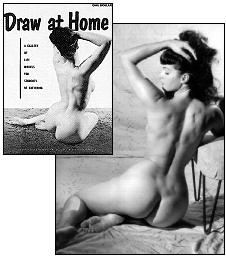 |
Some poses resembled those in the stunning drawings of Alberto Vargas, some were more like the arty postures typical of the time. |
 At the same time as Bettie posed for those healthy looking beach pictures, she also posed for Irving Klaw's mail orders. Here she appeared with whips and leather, tied up, or wrestling with some other girl in underwear. This was the dark angel side of Bettie Page, according to Essex & Swanson. But with Bettie's attitude to it all, there seems to have been no discrepancy between the different kinds of modeling.
At the same time as Bettie posed for those healthy looking beach pictures, she also posed for Irving Klaw's mail orders. Here she appeared with whips and leather, tied up, or wrestling with some other girl in underwear. This was the dark angel side of Bettie Page, according to Essex & Swanson. But with Bettie's attitude to it all, there seems to have been no discrepancy between the different kinds of modeling. Some of her wrestling scenes recall shots from the movie "Bitter Rice", directed by Giuseppe de Santis in 1948, with Silvana Mangano. But that was Italy. Hollywood was not ready for this. Such material had to stay under the counter.
Some of her wrestling scenes recall shots from the movie "Bitter Rice", directed by Giuseppe de Santis in 1948, with Silvana Mangano. But that was Italy. Hollywood was not ready for this. Such material had to stay under the counter. Irving Klaw and his sister Paula had started by selling publicity photos from Hollywood, through their firm Movie Star News, but soon public demand for heavier stuff made them set up their own studio at 14th Street. We learn, from the Essex & Swanson book, that the bondage scenes were inspired by "Little John", who held a "high profile federal job" and who still is anonymous. Little John also financed much of the props - things such as fancy silk or leather garments and specially made high-heels.
Irving Klaw and his sister Paula had started by selling publicity photos from Hollywood, through their firm Movie Star News, but soon public demand for heavier stuff made them set up their own studio at 14th Street. We learn, from the Essex & Swanson book, that the bondage scenes were inspired by "Little John", who held a "high profile federal job" and who still is anonymous. Little John also financed much of the props - things such as fancy silk or leather garments and specially made high-heels.  With the Klaws Bettie also made about 50 short films, with titles such as Tambourine Dance or French Garter Fight. From the book you get the impression that Bettie really did all this work with that light touch that the images convey. She obviously had a strong sense of integrity and never sunk into some sort of porno cesspool. She continued her acting classes and never tried to get herself a career by sleeping with important men. She even turned down Howard Hughes.
With the Klaws Bettie also made about 50 short films, with titles such as Tambourine Dance or French Garter Fight. From the book you get the impression that Bettie really did all this work with that light touch that the images convey. She obviously had a strong sense of integrity and never sunk into some sort of porno cesspool. She continued her acting classes and never tried to get herself a career by sleeping with important men. She even turned down Howard Hughes. 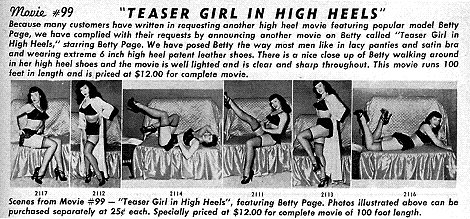
 In the mid 50's there were a lot of investigations going on, not only of the alleged communist infiltration within the movie industry, but of all sorts of culture regarded as indecent and harmful to moral standards. In 1956 the Elia Kazan movie Baby Doll with Karl Malden was banned by the Legion of Decency. In 1955 Irving Klaw became subject to a senate investigation, that tried to link pornography with juvenile delinqency. Klaw couldn't stand up to this kind of pressure, and in '57 he closed his business - and that also put an end to Bettie's modeling years.
In the mid 50's there were a lot of investigations going on, not only of the alleged communist infiltration within the movie industry, but of all sorts of culture regarded as indecent and harmful to moral standards. In 1956 the Elia Kazan movie Baby Doll with Karl Malden was banned by the Legion of Decency. In 1955 Irving Klaw became subject to a senate investigation, that tried to link pornography with juvenile delinqency. Klaw couldn't stand up to this kind of pressure, and in '57 he closed his business - and that also put an end to Bettie's modeling years.  The revival we are now experiencing at its peak first started in 1979, when Belier Press in New York reprinted some of the pictures from private photo sessions in four volumes, titled Betty Page - Private Peeks. This was about twenty years after she had ceased to appear in print. Back in '79 she was known mostly among fans in their forties and fifties and to some younger aficionados. The editor of Private Peeks volume 2 wrote that whatever became of Bettie, that is the question:
The revival we are now experiencing at its peak first started in 1979, when Belier Press in New York reprinted some of the pictures from private photo sessions in four volumes, titled Betty Page - Private Peeks. This was about twenty years after she had ceased to appear in print. Back in '79 she was known mostly among fans in their forties and fifties and to some younger aficionados. The editor of Private Peeks volume 2 wrote that whatever became of Bettie, that is the question:  "There have been various stories, mostly erroneous about murder, suicide, a religious conversion and living in convent, but the most recent, best researched and almost certainly the most accurate is that Bettie Page is Alive and Well, lives in the South and has developed a Deep Religious belief in Christianity."
"There have been various stories, mostly erroneous about murder, suicide, a religious conversion and living in convent, but the most recent, best researched and almost certainly the most accurate is that Bettie Page is Alive and Well, lives in the South and has developed a Deep Religious belief in Christianity." This was of course the perfect myth for a budding legend like Bettie Page: she should be either dead or religious - or preferably a combination of both - maybe absorbed in some sort of repentant social work, a kind of Major Barbara.
This was of course the perfect myth for a budding legend like Bettie Page: she should be either dead or religious - or preferably a combination of both - maybe absorbed in some sort of repentant social work, a kind of Major Barbara.  There really was some truth in those rumours, she had developed an interest in spiritual matters. When Irving Klaw had terminated his business, Bettie moved back to Florida and married an old boyfriend, Armond Walterson. This marriage bored her, they didn't really have much in common, and Bettie's interest was directed towards religion. She had a commanding experience at a local church, and later on, when she had left Armond and moved to Los Angeles, she also joined the Bible Institute of Los Angeles.
There really was some truth in those rumours, she had developed an interest in spiritual matters. When Irving Klaw had terminated his business, Bettie moved back to Florida and married an old boyfriend, Armond Walterson. This marriage bored her, they didn't really have much in common, and Bettie's interest was directed towards religion. She had a commanding experience at a local church, and later on, when she had left Armond and moved to Los Angeles, she also joined the Bible Institute of Los Angeles.  In L.A. she lived a secluded life, working as a secretary, e.g. for the Bible Institute and for Compton's Encyclopedia. She spent some time working for Billy Graham, and she also worked as a counselor, helping unmarried pregnant teenagers.
In L.A. she lived a secluded life, working as a secretary, e.g. for the Bible Institute and for Compton's Encyclopedia. She spent some time working for Billy Graham, and she also worked as a counselor, helping unmarried pregnant teenagers.  After divorcing Armond, she remarried her first husband Billy and lived with him for some time, but he almost killed her in a fight, so she left again. (I doubt that Hollywood can keep away from making a movie out of this in - shall we say a year or two? As a matter of fact, Demi Moore has already posed for some ludicrous stills as Bettie Page.)
After divorcing Armond, she remarried her first husband Billy and lived with him for some time, but he almost killed her in a fight, so she left again. (I doubt that Hollywood can keep away from making a movie out of this in - shall we say a year or two? As a matter of fact, Demi Moore has already posed for some ludicrous stills as Bettie Page.) In '67 Bettie met Harry Lear, who became her third husband. A good marriage in many ways it seems, but difficult, since Lear's former wife wouldn't leave him and Bettie in peace. Still, they managed to live together - more or less - for some eleven years.
In '67 Bettie met Harry Lear, who became her third husband. A good marriage in many ways it seems, but difficult, since Lear's former wife wouldn't leave him and Bettie in peace. Still, they managed to live together - more or less - for some eleven years. 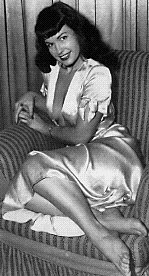
This brings us to the year 1978, when the revival slowly picked up steam with the release of the first of Belier's Private Peeks. Robert Blue also made his - in my opinion - hideous airbrush paintings of famous Bettie Page poses. (I can imagine why he made them. There is no other way to really make a paper doll a doll the other fellas cannot steal. But then, why publish them?)
 During the 80's and early 90's Bettie Page appeared in comic strips, by Eric Stanton and Dave Stevens for instance, illustrators like Frank Frazetta or Olivia De Barardinis drew and painted her, she ended up on posters for rock bands, and today crowds of Bettie Page look-alikes are filling the runways and covers of fashion magazines. Bettie even paved the way for a model's right to smile again in fashion photography. But nobody can, of course, compete with the real Bettie:
During the 80's and early 90's Bettie Page appeared in comic strips, by Eric Stanton and Dave Stevens for instance, illustrators like Frank Frazetta or Olivia De Barardinis drew and painted her, she ended up on posters for rock bands, and today crowds of Bettie Page look-alikes are filling the runways and covers of fashion magazines. Bettie even paved the way for a model's right to smile again in fashion photography. But nobody can, of course, compete with the real Bettie:
 "I've never seen the impish glee in Bettie's eyes in any other model," says fashion editor of USA Today, Elizabeth Snead, in the Essex & Swanson book. And photographer Albert Watson is also quoted: "She may have appeared in cheap magazines, on cheap postcards, or was shot by some bad photographers, but she always rose above that. Seventy or eighty percent of her photographs, you could run in Vogue."
"I've never seen the impish glee in Bettie's eyes in any other model," says fashion editor of USA Today, Elizabeth Snead, in the Essex & Swanson book. And photographer Albert Watson is also quoted: "She may have appeared in cheap magazines, on cheap postcards, or was shot by some bad photographers, but she always rose above that. Seventy or eighty percent of her photographs, you could run in Vogue."
 Today's models may cram the fashion scene with all of Bettie Page's fetish ware in slightly updated versions by Versace or Dolce & Gabbana, and some of them may even resemble Bettie, but they certainly don't look as healthy.
Today's models may cram the fashion scene with all of Bettie Page's fetish ware in slightly updated versions by Versace or Dolce & Gabbana, and some of them may even resemble Bettie, but they certainly don't look as healthy.
 As illustrator John Silke points out in his book Bettie Page, Queen of Hearts (Dark Horse Books, Milwaukie, Oregon, 1995, ISBN 1-56971-124-0), Bettie seems to be in motion, even in her stills, they have a before and an after. We can imagine Bunny Yeager or Paula Klaw asking her to adopt yet another pose, or we can invent our own narrative ... This sense of motion is not so much a question of pose, or of certain angles of legs and arms, but mostly a question of her facial expression, her gaze. Intended motion, not mimicked motion.
As illustrator John Silke points out in his book Bettie Page, Queen of Hearts (Dark Horse Books, Milwaukie, Oregon, 1995, ISBN 1-56971-124-0), Bettie seems to be in motion, even in her stills, they have a before and an after. We can imagine Bunny Yeager or Paula Klaw asking her to adopt yet another pose, or we can invent our own narrative ... This sense of motion is not so much a question of pose, or of certain angles of legs and arms, but mostly a question of her facial expression, her gaze. Intended motion, not mimicked motion.
 "It seemed she would anticipate just what I wanted," Bunny Yeager says in Silke's book, "I would just throw adjectives at her, 'Look devilish! Questioning! Seductive! Surprised! Breathless! Innocent! Vivacious! Wanton! Dominating! Teasing!' It was like we were dancing together". "I was expressing myself with her body instead of mine," Yeager explains in Essex & Swanson. Bettie, on the other hand, says to Essex & Swanson that she tried to imagine the camera as if it were a man.
"It seemed she would anticipate just what I wanted," Bunny Yeager says in Silke's book, "I would just throw adjectives at her, 'Look devilish! Questioning! Seductive! Surprised! Breathless! Innocent! Vivacious! Wanton! Dominating! Teasing!' It was like we were dancing together". "I was expressing myself with her body instead of mine," Yeager explains in Essex & Swanson. Bettie, on the other hand, says to Essex & Swanson that she tried to imagine the camera as if it were a man.
... still nice and pleasant somehow. No matter how bizarre the situation, she nevertheless kept her cheerful attitude. 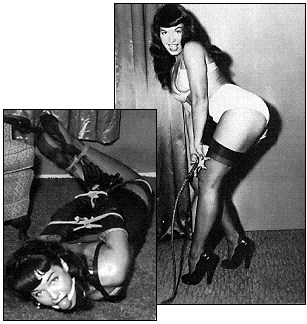
 Of course, pornography, even the purely visual, is in need of a story. Sex needs only action, but pornography needs a story. Pictures with certain props suggest all sorts of happenings, whether it be just a telephone or whips and ropes. But even without those things, Bettie always told a story, alluding with her face to a long tradition of illustrations for pulp detective stories, and not least, the artwork that accompanied stories and serials in womens magazines of the 40's and 50's.
Of course, pornography, even the purely visual, is in need of a story. Sex needs only action, but pornography needs a story. Pictures with certain props suggest all sorts of happenings, whether it be just a telephone or whips and ropes. But even without those things, Bettie always told a story, alluding with her face to a long tradition of illustrations for pulp detective stories, and not least, the artwork that accompanied stories and serials in womens magazines of the 40's and 50's.
 Bettie had a special talent for posing, that is obvious, even judging from the amateur pictures. Although they often were badly staged and lit, they convey the same persona, so it couldn't have been just in the eye of the professional photographer.
Bettie had a special talent for posing, that is obvious, even judging from the amateur pictures. Although they often were badly staged and lit, they convey the same persona, so it couldn't have been just in the eye of the professional photographer.
 There are some pictures where she seems almost caught off-guard, were she reveals for a possibly unintended moment, an expression of some strange gravity. It would be easy to imagine this as the true Bettie - and the smiling Bettie as a commercial trademark, forced upon her by exploitation. Her sign were the smile and the bangs, and it was probably her very own. The 50's was a dashing decade alright, filled with post-war optimism - and maybe a trace of paranoia - but smiling bondage queens were not that common. The innocence of that scant and sweet clothing of her own design, together with occasional whips and ropes, made her at the same time both good and bad. But the off-guard pictures seem neither good nor bad; they just signal some kind of danger.
There are some pictures where she seems almost caught off-guard, were she reveals for a possibly unintended moment, an expression of some strange gravity. It would be easy to imagine this as the true Bettie - and the smiling Bettie as a commercial trademark, forced upon her by exploitation. Her sign were the smile and the bangs, and it was probably her very own. The 50's was a dashing decade alright, filled with post-war optimism - and maybe a trace of paranoia - but smiling bondage queens were not that common. The innocence of that scant and sweet clothing of her own design, together with occasional whips and ropes, made her at the same time both good and bad. But the off-guard pictures seem neither good nor bad; they just signal some kind of danger.
 The both complex and straightforward, for short: enigmatic, nature of Bettie Page, together with the fact that she has not yet been used up by the proper movie industry, like Marilyn Monroe or James Dean, makes her perfect as raw material for contemporary dreams. The risk of course could be that a book like this de-iconizes her, remoulds her into a human like us, with everyday problems. On the other hand, that will probably work too. After all, we do live in the age of Ricki Lake and Oprah Winfrey.
The both complex and straightforward, for short: enigmatic, nature of Bettie Page, together with the fact that she has not yet been used up by the proper movie industry, like Marilyn Monroe or James Dean, makes her perfect as raw material for contemporary dreams. The risk of course could be that a book like this de-iconizes her, remoulds her into a human like us, with everyday problems. On the other hand, that will probably work too. After all, we do live in the age of Ricki Lake and Oprah Winfrey.
See also:
![]() Starwave's Celebrity Lounge interview with Bettie Page, March 1996
Starwave's Celebrity Lounge interview with Bettie Page, March 1996
![]() A Bettie Page Hyperlist of Sites
A Bettie Page Hyperlist of Sites
About the author.